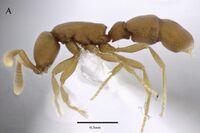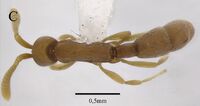Probolomyrmex brujitae
| Probolomyrmex brujitae | |
|---|---|

| |
| Scientific classification | |
| Kingdom: | Animalia |
| Phylum: | Arthropoda |
| Class: | Insecta |
| Order: | Hymenoptera |
| Family: | Formicidae |
| Subfamily: | Proceratiinae |
| Tribe: | Probolomyrmecini |
| Genus: | Probolomyrmex |
| Species: | P. brujitae |
| Binomial name | |
| Probolomyrmex brujitae Agosti, 1995 | |
All known specimens of this species were obtained from leaf-litter samples, with the two type specimens being collected by Winkler bags of sifted leaf litter from a secondary Yungas forest.
Identification
Oliveira & Feitosa (2019) - Postero-ventral lobe of petiole long and subquadrate. Subpetiolar process weakly developed and anteriorly directed. Prora and protuberance on posterior region of first gastral tergite absent.
This species differs from all others by the weak, anteriorly directed subpetiolar process.
Keys including this Species
Distribution
Latitudinal Distribution Pattern
Latitudinal Range: -14.31666667° to -27.5602°.
| North Temperate |
North Subtropical |
Tropical | South Subtropical |
South Temperate |
- Source: AntMaps
Distribution based on Regional Taxon Lists
Neotropical Region: Argentina (type locality), Brazil.
Distribution based on AntMaps
Distribution based on AntWeb specimens
Check data from AntWeb
Countries Occupied
| Number of countries occupied by this species based on AntWiki Regional Taxon Lists. In general, fewer countries occupied indicates a narrower range, while more countries indicates a more widespread species. |

|
Estimated Abundance
| Relative abundance based on number of AntMaps records per species (this species within the purple bar). Fewer records (to the left) indicates a less abundant/encountered species while more records (to the right) indicates more abundant/encountered species. |

|
Biology
Castes
Worker
Queen
Images from AntWeb
   
| |
| Paratype of Probolomyrmex brujitae. Queen (alate/dealate). Specimen code casent0104672. Photographer April Nobile, uploaded by California Academy of Sciences. | Owned by AMNH, New York, NY, USA. |
Nomenclature
The following information is derived from Barry Bolton's Online Catalogue of the Ants of the World.
- brujitae. Probolomyrmex brujitae Agosti, 1995: 433, figs. 5, 6, 9, 10, 14 (w.q.) ARGENTINA (Jujuy).
- Type-material: holotype worker, 1 paratype queen.
- Type-locality: holotype Argentina: Jujuy, Aguas Blancas-Yaculica, Yungas Forest, 22°43’44’’S, 64°22’25’’W, 460 m., 55.x.1994 (D. Agosti & J.M. Carpenter); paratype with same data.
- Type-depositories: MCZC (holotype); IMLT (paratype).
- [Note: paratype in IMLT according to Agosti, but in AMNH according to Oliveira & Feitosa, 2019: 72.]
- Status as species: O’Keefe & Agosti, 1998: 190 (in key); Feitosa, 2015c: 99; Oliveira & Feitosa, 2019: 72 (redescription).
- Distribution: Argentina, Brazil.
Unless otherwise noted the text for the remainder of this section is reported from the publication that includes the original description.
Description
Oliveira & Feitosa (2019) - Worker measurements: (n=12) HL 0.48–0.56; HW 0.30–0.33; SL 0.28–0.33; WL 0.61–0.70; PL 0.22–0.34; PW 0.24–0.26; PH 0.20–0.24; TL 2.17–2.41; CI 56.5–64; SI 56.5–64.5; PI 75.5–92.5.
Worker description: Frontoclypeal shelflike projection and mandibles foveolate, with hair-bearing tubercles or cylindrical micro-pegs; external surface of mandibular basal margin transversely striolate. Tip of apical antennal segment bearing minute pits. Mesopleuron, metapleuron and lateral faces of propodeum alveolate and foveate; alveoli denser just above metapleural gland orifice; opening of metapleural gland narrow, with smooth anterior region, surrounded by rows of hairs. Petiolar node foveate, interval between foveae covered by micropunctures (punctulae); postero-ventral lobe and latero-ventral region of petiole alveolate, with short hair projecting from each alveolus; subpetiolar process alveolate. Posterior region of second gastral segment with foveae.
Space between mesosomal foveae covered by dense pubescence. Pygidium with hair-bearing tubercles or cylindrical micro-pegs.
Head 1.6 times longer than wide. Hypostomal margin curved. Antennal scapes extend to head mid length, distance from scape apex to of head more than two times pedicel length (SI 56.5–64.5). Propodeal declivity with lateral carina, laterodorsal teeth present. Petiole in lateral view at least 1.2 times longer than high (PI 75.5–92.5), apex with two weakly developed posterior teeth; posterior face short, concave and smooth; postero-ventral lobe long and subquadrate; subpetiolar process weakly developed and directed anteriorly. First gastral segment without prora or dorsal protuberance on posterior region of tergite.
Queen
Oliveira & Feitosa (2019) - (n=3) HL 0.50–0.52; HW 0.32–0.33; SL 0.31–0.33; WL 0.67; PL 0.23–0.25; PH 0.21–0.22; TL 2.21– 2.28. CI 64.5; SI 62.5–64.5; PI 85.5–92.
Queen presents the characters already described in the genus description and the diagnostic characters of the workers.
Type Material
- Holotype 1 worker, Argentina, Jujuy, Aguas Blancas-Yaculica (Argentinian-Bolivian Frontier), 22°43'44"S 64°22'25"W, 460 m, 25 October 1994, D. Agosti & J. M. Carpenter, Winkler sample, leaf litter, Yungas forest (Museum of Comparative Zoology).
- Paratype 1 female, same Winkler sample as holotype. Publication says deposited at Instituto Miguel Lillo Tucuman but Oliveira & Feitosa (2019) note this specimen is present in American Museum of Natural History (www.antweb.org; specimen CASENT0104672).
Taxonomic Notes
Oliveira & Feitosa (2019) - There is a record of a single individual of P. brujitae in Bahia, Brazil (Nascimento et al. 2004). However, after careful examination of the specimen, we concluded it actually corresponds to a different and undescribed species. We refrain from describing it since the only known specimen is in very poor condition.
References
- Agosti, D. 1995 [1994]. A revision of the South American species of the ant genus Probolomyrmex (Hymenoptera: Formicidae). Journal of the New York Entomological Society. 102:429-434. (page 433, figs. 5, 6, 9, 10, 14 worker, queen described)
- Nascimento, I. C.; Delabie, J. H. C.; Campiolo, Sofia; Mariano Neto, Eduardo 2004. Présence de Probolomyrmex brujitae Agosti, 1994, au Brésil (Hym., Formicidae). Bull. Soc. Entomol. Fr. 109(3): 321-322 (page 321, new record Brazil)
- Oliveira, A.M., Feitosa, R.M. 2019. Taxonomic revision of the genus Probolomyrmex Mayr, 1901 (Hymenoptera: Formicidae: Proceratiinae) for the Neotropical Region. Zootaxa 4614 (1): 61–94 (doi:10.11646/zootaxa.4614.1.3).
References based on Global Ant Biodiversity Informatics
- Oliveira A. M., and R. M. Feitosa. 2019. Taxonomic revision of the genus Probolomyrmex Mayr, 1901 (Hymenoptera: Formicidae: Proceratiinae) for the Neotropical Region. Zootaxa 4614: 61–94.



